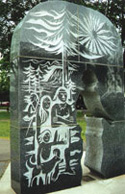Proactive disclosure
Print version   |  | 
Natural Resources Canada > Earth Sciences Sector > Priorities > Geoscape Canada > Québec
Geoscape Québec The Rocks Are Part of Our History
| The granites of the Grenville Province |
The opening of a railway in 1875 meant that the Rivière-à-Pierre granite could be mined. This rock, which is twice as old as the other rocks of the Québec region, is also much more resistant. It is highly valued for use as paving stones and monument bases. The piers of the Québec Bridge were carved from Rivière-à-Pierre granite, as was the pedestal for the Statue of Liberty in New York.

The first meeting between white man and Native American, Cartier-Bréboeuf Park.
|
|

Québec Bridge
|
|

Saint-Coeur-de-Marie Church, 580, Grande-Allée Est
|
|
(Courtesy of R. Ledoux) |
| Building stone from the St. Lawrence Platform |
In the seventeenth and early eighteenth centuries, Beauport limestone was quarried and transported by barge to Québec to be used primarily as dimension stone and to produce lime for masonry work. Beauport limestone was used extensively to build the Québec fortifications. Until very recently, it was also used by the Beauport quarry, which supplied the Saint-Laurent cement factory. The armoury and several of the dwellings around Place-Royale were constructed of Beauport limestone. Later on, one after the other, the Côte-de-Beaupré, Pointe-aux-Trembles, and Saint-Marc-des-Carrières limestones, and finally the Ange-Gardien sandstone, were used for building purposes.
| Building stone from the Appalachian Orogen |
After the 1682 fire in Québec's Lower Town, people were encouraged to build stone houses. The first stone used came from the Québec promontory, right in the heart of the city, and was referred to as "cap stone" or "Québec stone". Around 1740, builders began to work with the greenish Sillery-Cap-Rouge sandstone that now forms part of the Québec fortifications and the walls of the Citadel, and that was used to rebuild the Saint-Jean Gate in 1938.
| The unconsolidated Quaternary materials |
The sand and gravel deposits left behind by glacial meltwater are now the site of gravel pits and are being used as a source of aggregate for concrete and road construction.

Grand théâtre de Québec
|
|

Rebuilding autoroute Charest
|
|

Marie-Guyart Building
|
|
(Courtesy of R. Ledoux) |
|
